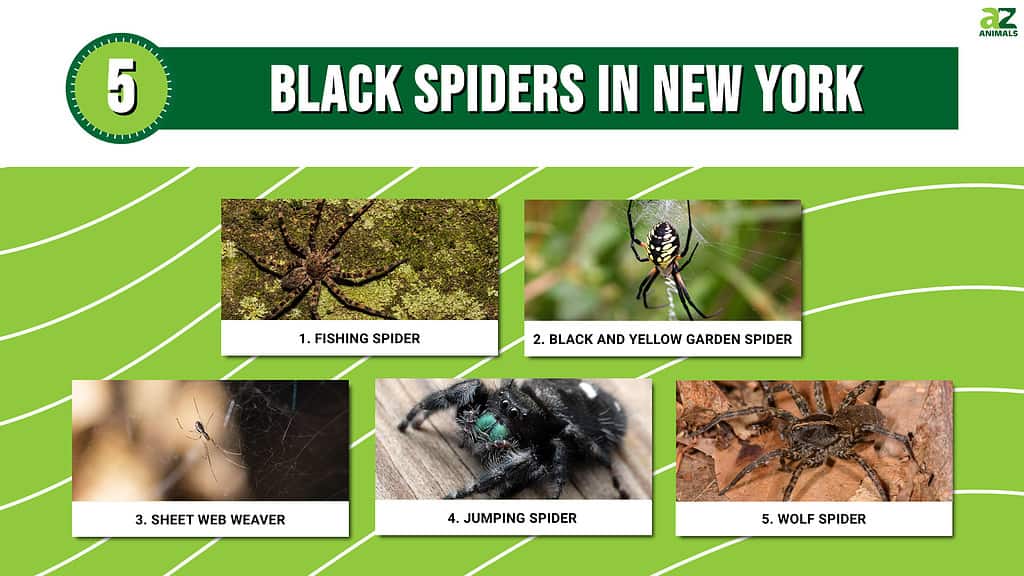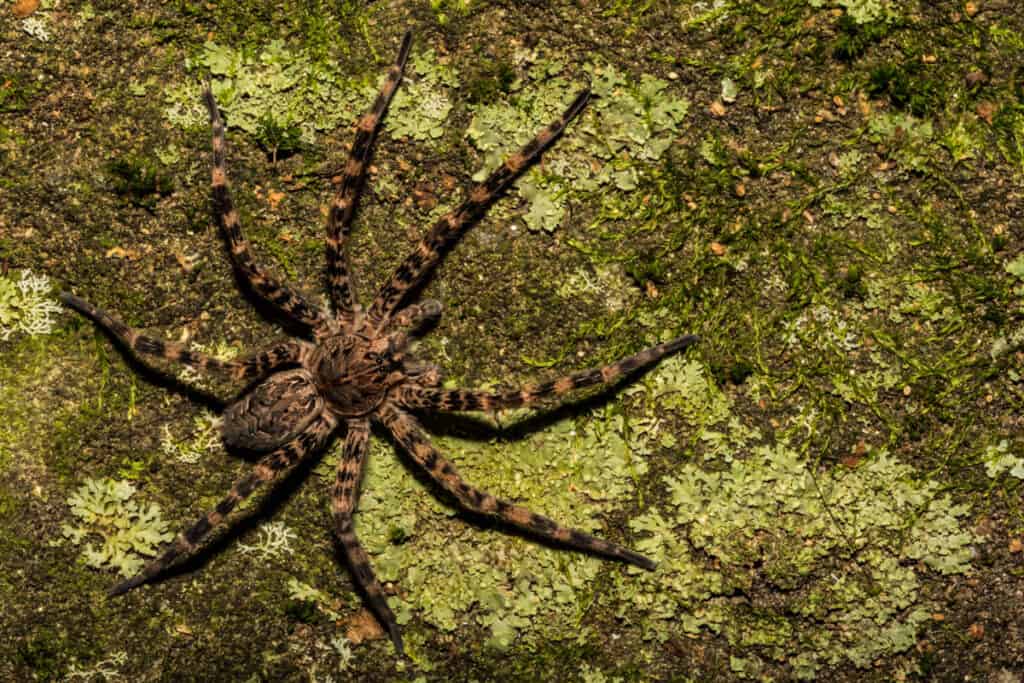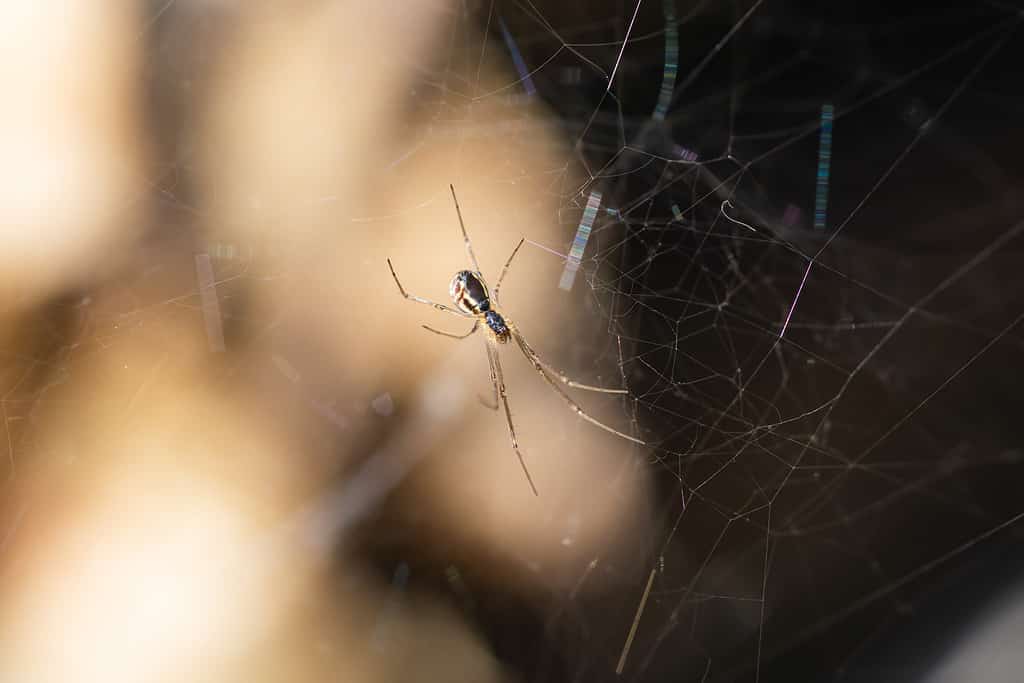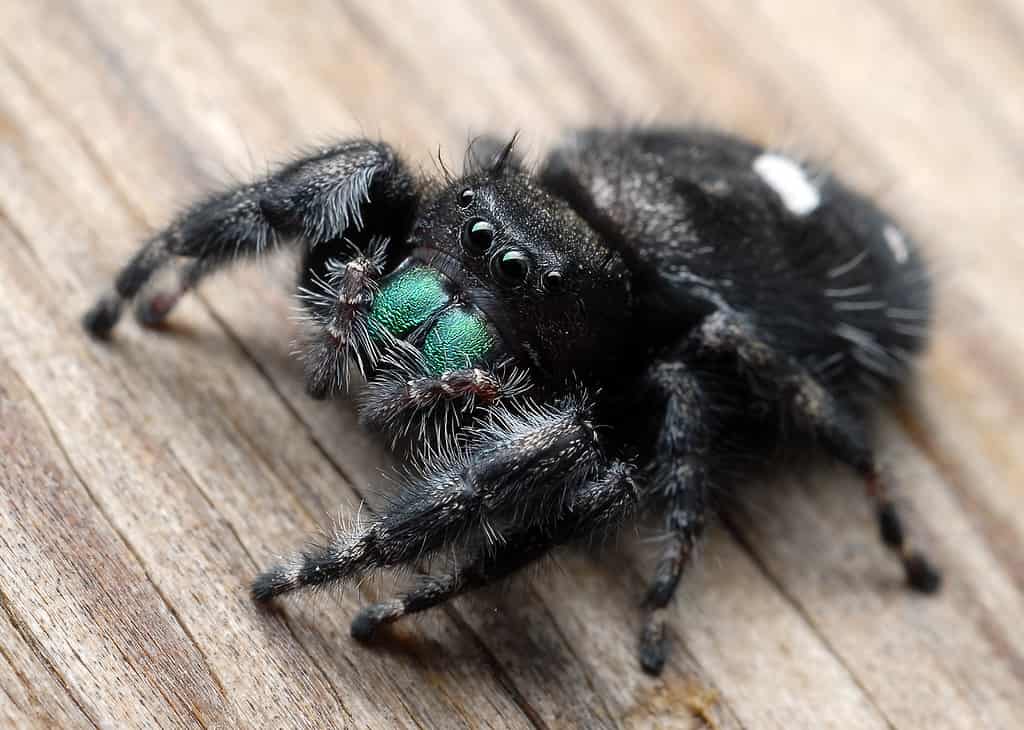
Just like New Yorkers, some spiders carry out most of their activities during the day while others come alive at night. There are huge spiders that can literally walk on water and there are tiny, adorable ones with clever abilities. Some spiders want to be seen while others hide out so well, you’re likely to never spot them. Just as there are sky-high buildings in the city, there are also little creatures dwelling closer to the ground. Although there are a wide variety of arachnids that call New York home, in this article, we focus on black spiders!
5 Black Spiders in New York
1. Fishing Spider
Scientific Name: Dolomedes

These dark-colored spiders have a unique ability to walk on water thanks to their hydrophobic velvet-like hairs.
©iStock.com/JasonOndreicka
Fishing spiders are some of the biggest spiders you’ll encounter in New York. These dark-colored spiders have a unique ability to walk on water thanks to their hydrophobic velvet-like hairs. This allows them to stand atop water without sinking and permits them to run along the water, which is how they capture their prey. Once they see a little ripple, they know something of interest is there and they head on over. Most of them eat insects as their primary diet but these spiders are big enough (with a leg span of up to three inches) to catch small fish too. As if that weren’t unnerving enough, these spiders have specialized lungs that allow them to continue their hunting activities underneath the water’s surface. They’re buoyant, so in order to stay submerged, they need to cling to something like an underwater plant. Although a bit shocking when you encounter one, these spiders are harmless to humans and may even be of service, since they take down insects that may otherwise show interest in you!
2. Black And Yellow Garden Spider
Scientific Name: Argiope aurantia

This spider doesn’t just set up its web in open gardens, its colorations are also bright and attractive, catching your eye even from afar.
©iStock.com/AwakenedEye
Many spiders prefer dark burrows, room corners, or debris-littered environments so they can hide and blend in, going unnoticed. However, the black and yellow garden spider is the complete opposite. This spider doesn’t just set up its web in open gardens, its colorations are also bright and attractive, catching your eye even from afar. They’re bright yellow and black and they spin large webs with rather chaotic, zig-zagged centers. They are active during the day, and they love the sunlight, preferring to set up in environments where the light glitters against the sheen of their webs. Female spiders are hundreds of times bigger than their male counterparts. Their webs serve multiple purposes, with the middle being dense enough to deter birds while the sticky bits are perfect for trapping prey.
3. Sheet Web Weaver
Scientific Name: Linyphiidae

Although common in the state, sheet web weavers aren’t commonly spotted.
©Erik Agar/Shutterstock.com
Although common in the state, sheet web weavers aren’t commonly spotted. Unlike the other two spiders we’ve already identified in this list, sheet web weavers are quite small (less than ¼ inch long). They don’t set up their webs in open environments — instead, they seek out vegetation close to the ground. This is where they set up their fine sheet webs, away from prying eyes. These non-sticky webs are used to capture unsuspecting prey that crashes into the vertical threads and falls down to the sheet web, where the sheet web weaver has the convenience of biting them right through their webs. These spiders are dark and shiny with different colorations, including black and red and black and brown.
4. Jumping Spider
Scientific Name: Salticidae

Jumping spiders
may make their way closer to New Yorkers as they find mailboxes and windowsills cozy.
©Miles Boyer/Shutterstock.com
Jumping spiders may make their way closer to New Yorkers as they find mailboxes and windowsills cozy. They also enjoy hanging out around plants. They’re tiny, however, and not easy to spot unless you’re looking for them. These spiders are known for their incredible intelligence and their ability to jump great distances (up to 50 times their own length!). They don’t weave webs to capture prey; instead, they actively hunt, using the light of the day. They do produce silk; however, they use it almost like a bungee cord. Before they jump, they lower their abdomens to the surface to establish their draglines. These black spiders with white markings and greenish/bluish metallic eyes have stubby bodies — and they are very clever!
5. Wolf Spider
Scientific Name: Lycosidae

The
wolf spider has dark colorations that appear black
, including brown, dark brown, and gray.
©Marshal Hedin / Creative Commons – License
The wolf spider has dark colorations that appear black, including brown, dark brown, and gray. They are large, furry spiders, that may intimidate the most fearless person at first glance. Their legs are very sturdy, and they have a total of eight eyes, which gives them great vision. These spiders are typically found close to the ground, sometimes hanging out in the lower portions of plants. In New York, you can spot these by heading out after nightfall. If you take a flashlight with you and point it downward, you will spot several silvery reflections. These are the eyes of wolf spiders hanging out in their preferred close-to-the-ground environment. They are not aggressive so long as they are not perturbed. Humans may accidentally agitate these spiders, however, and a bite results in pain, swelling, and inflammation.
The photo featured at the top of this post is © Vinicius R. Souza/Shutterstock.com
Thank you for reading! Have some feedback for us? Contact the AZ Animals editorial team.






